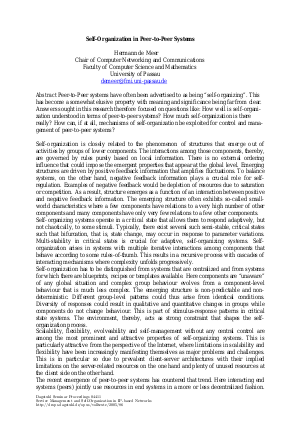Self-Organization in Peer-to-Peer Systems
Author Hermann de Meer
-
Part of:
Volume:
Dagstuhl Seminar Proceedings, Volume 4411
Part of: Series: Dagstuhl Seminar Proceedings (DagSemProc) - License:
 Creative Commons Attribution 4.0 International license
Creative Commons Attribution 4.0 International license
- Publication Date: 2005-03-24
File

PDF
DagSemProc.04411.17.pdf
- Filesize: 42 kB
- 2 pages
Document Identifiers
Subject Classification
Keywords
- self-organization
- peer-to-peer
Metrics
- Access Statistics
-
Total Accesses (updated on a weekly basis)
0Document
0Metadata
Abstract
Peer-to-Peer Systems are about community-based cooperations. The peers share responsibilities and benefits by cooperating in a distributed and decentralized environment. To carry out tasks sensibly, however, a more or less rigid order is required for efficiency and reliability reasons. This order can be partially imposed from the outside, for example within so-called "structed" Peer-to-Peer systems. A common approach here is the use of Distributed Hash Tables. Alternatively, Peer-to-Peer systems can be "unstructured" in the sense that an useful order emerges from own internal processes. Unstructured and structured Peer-to-Peer systems rely both on a more or less decentralized overlay management. Self-organization, therefore, is a key to the success of Peer-to-Peer systems in various forms. This presentation gives an overview of the role of self-organization in Peer-to-Peer systems.
Cite As Get BibTex
Hermann de Meer. Self-Organization in Peer-to-Peer Systems. In Service Management and Self-Organization in IP-based Networks. Dagstuhl Seminar Proceedings, Volume 4411, Schloss Dagstuhl – Leibniz-Zentrum für Informatik (2005)
https://doi.org/10.4230/DagSemProc.04411.17
BibTex
@InProceedings{meer:DagSemProc.04411.17,
author = {Meer, Hermann de},
title = {{Self-Organization in Peer-to-Peer Systems}},
booktitle = {Service Management and Self-Organization in IP-based Networks},
series = {Dagstuhl Seminar Proceedings (DagSemProc)},
ISSN = {1862-4405},
year = {2005},
volume = {4411},
editor = {Matthias Bossardt and Georg Carle and D. Hutchison and Hermann de Meer and Bernhard Plattner},
publisher = {Schloss Dagstuhl -- Leibniz-Zentrum f{\"u}r Informatik},
address = {Dagstuhl, Germany},
URL = {https://drops.dagstuhl.de/entities/document/10.4230/DagSemProc.04411.17},
URN = {urn:nbn:de:0030-drops-860},
doi = {10.4230/DagSemProc.04411.17},
annote = {Keywords: self-organization , peer-to-peer}
}
